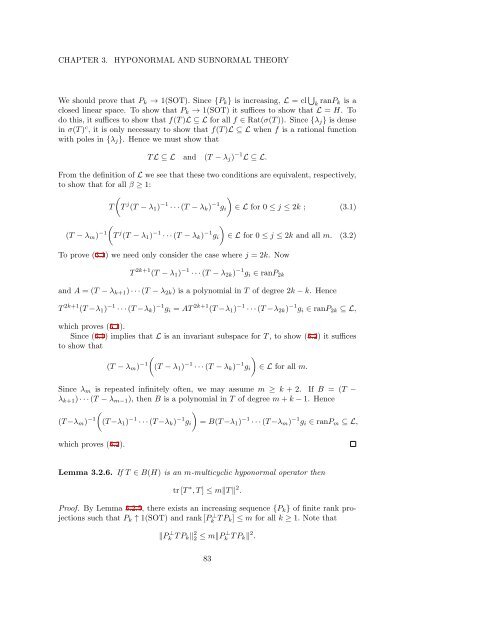Woo Young Lee Lecture Notes on Operator Theory
Woo Young Lee Lecture Notes on Operator Theory
Woo Young Lee Lecture Notes on Operator Theory
You also want an ePaper? Increase the reach of your titles
YUMPU automatically turns print PDFs into web optimized ePapers that Google loves.
CHAPTER 3.<br />
HYPONORMAL AND SUBNORMAL THEORY<br />
We should prove that P k → 1(SOT). Since {P k } is increasing, L = cl ∪ k ranP k is a<br />
closed linear space. To show that P k → 1(SOT) it suffices to show that L = H. To<br />
do this, it suffices to show that f(T )L ⊆ L for all f ∈ Rat(σ(T )). Since {λ j } is dense<br />
in σ(T ) c , it is <strong>on</strong>ly necessary to show that f(T )L ⊆ L when f is a rati<strong>on</strong>al functi<strong>on</strong><br />
with poles in {λ j }. Hence we must show that<br />
T L ⊆ L and (T − λ j ) −1 L ⊆ L.<br />
From the definiti<strong>on</strong> of L we see that these two c<strong>on</strong>diti<strong>on</strong>s are equivalent, respectively,<br />
to show that for all β ≥ 1:<br />
)<br />
T<br />
(T j (T − λ 1 ) −1 · · · (T − λ k ) −1 g i ∈ L for 0 ≤ j ≤ 2k ; (3.1)<br />
(T − λ m ) −1 (<br />
T j (T − λ 1 ) −1 · · · (T − λ k ) −1 g i<br />
)<br />
∈ L for 0 ≤ j ≤ 2k and all m. (3.2)<br />
To prove (3.1) we need <strong>on</strong>ly c<strong>on</strong>sider the case where j = 2k. Now<br />
T 2k+1 (T − λ 1 ) −1 · · · (T − λ 2k ) −1 g i ∈ ranP 2k<br />
and A = (T − λ k+1 ) · · · (T − λ 2k ) is a polynomial in T of degree 2k − k. Hence<br />
T 2k+1 (T −λ 1 ) −1 · · · (T −λ k ) −1 g i = AT 2k+1 (T −λ 1 ) −1 · · · (T −λ 2k ) −1 g i ∈ ranP 2k ⊆ L,<br />
which proves (3.1).<br />
Since (3.1) implies that L is an invariant subspace for T , to show (3.2) it suffices<br />
to show that<br />
(<br />
)<br />
(T − λ m ) −1 (T − λ 1 ) −1 · · · (T − λ k ) −1 g i ∈ L for all m.<br />
Since λ m is repeated infinitely often, we may assume m ≥ k + 2. If B = (T −<br />
λ k+1 ) · · · (T − λ m−1 ), then B is a polynomial in T of degree m + k − 1. Hence<br />
(<br />
)<br />
(T −λ m ) −1 (T −λ 1 ) −1 · · · (T −λ k ) −1 g i = B(T −λ 1 ) −1 · · · (T −λ m ) −1 g i ∈ ranP m ⊆ L,<br />
which proves (3.2).<br />
Lemma 3.2.6. If T ∈ B(H) is an m-multicyclic hyp<strong>on</strong>ormal operator then<br />
tr [T ∗ , T ] ≤ m∥T ∥ 2 .<br />
Proof. By Lemma 3.2.5, there exists an increasing sequence {P k } of finite rank projecti<strong>on</strong>s<br />
such that P k ↑ 1(SOT) and rank [P ⊥ k T P k] ≤ m for all k ≥ 1. Note that<br />
∥P ⊥ k T P k ∥ 2 2 ≤ m∥P ⊥ k T P k ∥ 2 .<br />
83













